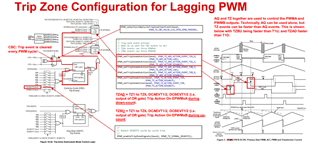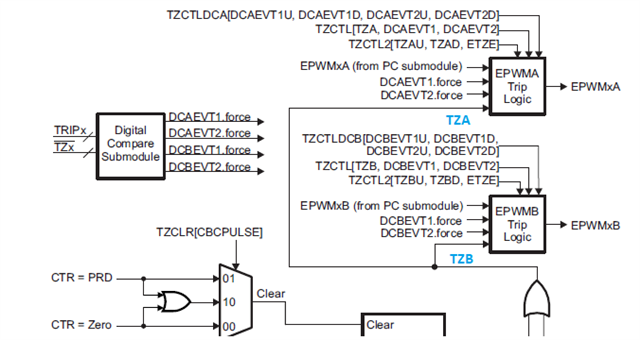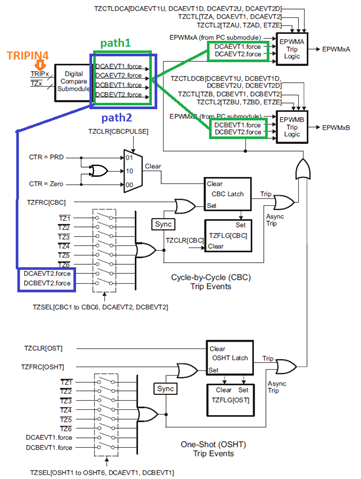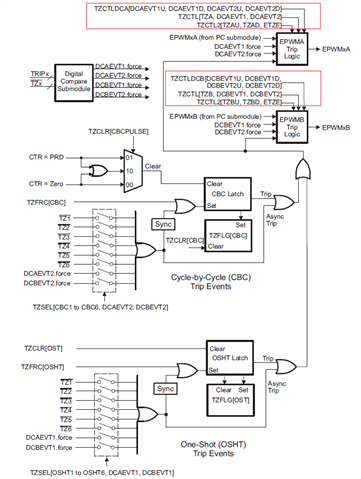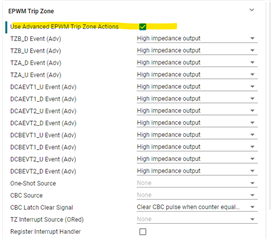Other Parts Discussed in Thread: C2000WARE
Hi,
I investigated PMP23126 software code.
At PSFB_HAL_setupBoardProtection function, I don't see base2 tripzone configuration.
// What do we want the OST/CBC events to do?
// TZA events can force EPWMxA
// TZB events can force EPWMxB
//
EPWM_setTripZoneAction(base1, EPWM_TZ_ACTION_EVENT_TZA, EPWM_TZ_ACTION_LOW);
EPWM_setTripZoneAction(base1, EPWM_TZ_ACTION_EVENT_TZB, EPWM_TZ_ACTION_LOW);
EPWM_setTripZoneAction(base3, EPWM_TZ_ACTION_EVENT_TZA, EPWM_TZ_ACTION_LOW);
EPWM_setTripZoneAction(base3, EPWM_TZ_ACTION_EVENT_TZB, EPWM_TZ_ACTION_LOW);
and when I check the PCMC==1 case, for ePWM base 2, I see following lines.
//
// Trip-zone event actions
// What do we want the CBC events to do?
// TZAx events can force EPWMxA
// TZBx events can force EPWMxB
//
EPWM_setTripZoneAdvAction(base2, EPWM_TZ_ADV_ACTION_EVENT_TZA_D,
EPWM_TZ_ADV_ACTION_LOW);
EPWM_setTripZoneAdvAction(base2, EPWM_TZ_ADV_ACTION_EVENT_TZA_U,
EPWM_TZ_ADV_ACTION_DISABLE);
EPWM_setTripZoneAdvAction(base2, EPWM_TZ_ADV_ACTION_EVENT_TZB_U,
EPWM_TZ_ADV_ACTION_LOW);
EPWM_setTripZoneAdvAction(base2, EPWM_TZ_ADV_ACTION_EVENT_TZB_D,
EPWM_TZ_ADV_ACTION_DISABLE);
EPWM_setTripZoneAction(base2, EPWM_TZ_ACTION_EVENT_TZA,
EPWM_TZ_ACTION_DISABLE);
EPWM_setTripZoneAction(base2, EPWM_TZ_ACTION_EVENT_TZB,
EPWM_TZ_ACTION_DISABLE);
1) Why didn't TI use following lines for protections? Please, explain in details.
EPWM_setTripZoneAction(base2, EPWM_TZ_ACTION_EVENT_TZA, EPWM_TZ_ACTION_LOW);
EPWM_setTripZoneAction(base2, EPWM_TZ_ACTION_EVENT_TZB, EPWM_TZ_ACTION_LOW);
2) When I set my own software and my own board in order to test protections, I observed that one of the ePWM2 (Output A or B) cannot have oneshot trip feature and continues to generate PWM signal at its output.
3) I don't think that I understood Figure 18-42 Trip-Zone Submodule Mode Control Logic. I cannot match driverlib functions and diagram to each other. Do you have suggestions?
Best regards.



